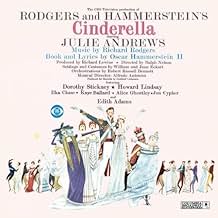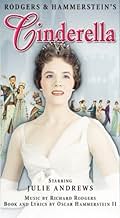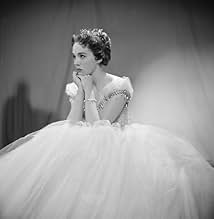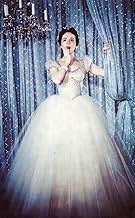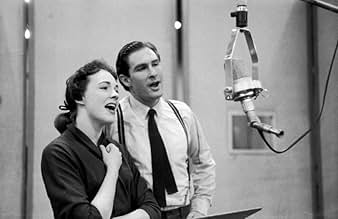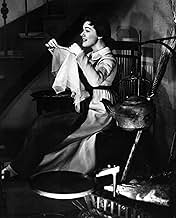Cinderella
- TV Movie
- 1957
- 1h 30m
IMDb RATING
7.5/10
1.3K
YOUR RATING
Although mistreated by her cruel Stepmother (Ilka Chase) and stepsisters Portia (Kaye Ballard) and Joy (Alice Ghostley), Cinderella (Dame Julie Andrews) is able to attend the royal ball thro... Read allAlthough mistreated by her cruel Stepmother (Ilka Chase) and stepsisters Portia (Kaye Ballard) and Joy (Alice Ghostley), Cinderella (Dame Julie Andrews) is able to attend the royal ball through the help of a Fairy Godmother (Edie Adams).Although mistreated by her cruel Stepmother (Ilka Chase) and stepsisters Portia (Kaye Ballard) and Joy (Alice Ghostley), Cinderella (Dame Julie Andrews) is able to attend the royal ball through the help of a Fairy Godmother (Edie Adams).
- Director
- Writers
- Stars
- Nominated for 3 Primetime Emmys
- 3 nominations total
Edie Adams
- Fairy Godmother
- (as Edith Adams)
Charles Aschmann
- Ensemble
- (uncredited)
Herbert Banke
- Ensemble
- (uncredited)
Donald Barton
- Ensemble
- (uncredited)
Julius J. Bloom
- Ensemble
- (uncredited)
Hank Brunjes
- Ensemble
- (uncredited)
Robert Burland
- Ensemble
- (uncredited)
Jean Caples
- Ensemble
- (uncredited)
- Director
- Writers
- All cast & crew
- Production, box office & more at IMDbPro
Featured reviews
Boy, those were the days, weren't they? They did the musical live before millions of Americans. All that choreography, singing, staging, lighting, props getting set, happened live before the cameras, a TV musical with no net. Julie Andrews was granted a short leave of absence from My Fair Lady in order to do it. Lucky for us Lerner and Loewe were so generous to their American counterparts, Rodgers and Hammerstein. I was not quite four when this show appeared, but I was blown away enough to want to go into musical theater from that point on. Yes, those were the days...when TV was used for something more important than selling Viagra.
Back in the golden age of television, when TV specials were just that, waiting for the broadcast of a show like "Cinderella" was truly an anticipated event. Add the names of Rodgers and Hammerstein and Star-in-the-making Julie Andrews, and you have an entertainment milestone! This was the celebrated songwriters only musical especially written for television, and it is a classic. The project was specifically intended to showcase Andrews (then appearing on Broadway in "My Fair Lady"). The hand-picked cast included Ilka Chase as the stepmother, Edie (here billed as Edith) Adams as the fairy godmother, and Broadway Stars Howard Lindsay and his wife, Dorothy Stickney as the king and queen. A newcomer, John Cypher, later to gain fame on ''Hill Street Blues'' was cast as the prince, and up and coming comedians Alice Ghostley and Kaye Ballard played the stepsisters. Because this was before the advent of videotape, the production was kine scoped while being broadcast live, although the original color kine scope was lost. Julie Andrews may look somewhat matronly (even at 21) to be Cinderella, but her lovely voice and star quality carry her through. Fans of "Mary Poppins" and "The Sound Of Music" will be pleasantly surprised to see how vulnerable she can be. Cypher is a suitable prince, with a good voice, while Adams is pushing a bit too hard as the godmother. Ilka chase, as the stepmother, and Ghostley and Ballard as the stepsisters are more silly than wicked. In all fairness though, this version was written more as a modern take off on the fairy tale, while the 1965 remake returned to the mood of the traditional story. The sets and costumes are rather cut-rate, somewhere between medieval and '50s modern, but they get by. Andrews is really the reason to see this, and it did attract a record audience at the time. The DVD is a treat with a remastered black-and white picture which, while not perfect, is good enough. There are several nice extras, including a documentary with Andrews, Cypher, Adams and Ballard reminiscing about the making of the production. Either for historic or entertainment reasons, "Cinderella" is well worth having. It's not every day you can watch a star being born.
Two decades into the 21st century, this 1957 TV special , "Cinderella," remains the most lavish and splendid live musical production ever done on TV. Thankfully, CBS recorded the broadcast and it's now on DVD. So, many decades later, people can still enjoy this splendid classic just as it aired on the night of March 31, 1957. Many other staged musicals and theatrical productions have been made since. But this is the original and benchmark fairy tale musical brought to life.
Julie Andrews stars in this super-sized stage production. A previously unknown singing actor leads the supporting cast. John Cypher plays Prince Christopher in his first ever film. Two superb Broadway masters play the king and queen - Howard Lindsay and Dorothy Stickney. The rest of the major roles are all excellently cast.
Of course one can tell that this is a stage production by the sets. But they are nevertheless well done. Everything about this production is excellent.
Andrews brings the story of Cinderella to life with the wonderful music of Richard Rodgers and Oscar Hammerstein II. This is a fine film of a classic fairy tale that the whole family should enjoy.
Julie Andrews stars in this super-sized stage production. A previously unknown singing actor leads the supporting cast. John Cypher plays Prince Christopher in his first ever film. Two superb Broadway masters play the king and queen - Howard Lindsay and Dorothy Stickney. The rest of the major roles are all excellently cast.
Of course one can tell that this is a stage production by the sets. But they are nevertheless well done. Everything about this production is excellent.
Andrews brings the story of Cinderella to life with the wonderful music of Richard Rodgers and Oscar Hammerstein II. This is a fine film of a classic fairy tale that the whole family should enjoy.
Due to the 1950s style production values of the sets I am limiting this to 1n 8, but if it had had 2005 set values it would be a 10.
Cinderella is one of the few fairy tales we grow up with that actually have been successfully used in entertainment mediums. Most people think of the Disney cartoon feature film of the early 1950s, but there was also THE GLASS SLIPPER, a full length film that appeared in the middle 1950s, the early 19th Century opera LA CENERENTOLA by Rossini, and even modern variations in film (MIDNIGHT in 1939 and CINDERFELLA in the 1960s). Then came this 1957 Rodgers and Hammerstein triumph. It was their only joint musical venture for television (although Richard Rodgers had done the them music for VICTORY AT SEA), and it proved so successful that it was shown again in 1965 with another cast led by Leslie Anne Warren, Walter Pigeon, and Ginger Rogers.
At the time the original television production was shown in 1957, it came at a critical moment for the lyricist and composer. They were doing well as producers, and they had a string of mighty successful works behind them (OKLAHOMA, CAROUSEL, SOUTH PACIFIC, and THE KING AND I), and they were very busy with the Hollywood productions of CAROUSEL and SOUTH PACIFIC at this time. But they were human: Several of their productions were not as successful. ALLEGRO (from the late 1940s) had an interesting book, but the music did not catch on (except one tune which was saved for SOUTH PACIFIC). ME AND JULIET, a backstage romance, had a middling run. PIPEDREAMS (based on the same stories of John Steinbeck that TORTILLA FLATS came from) was a total flop. Cinderella would be their first successful musical in five years. Soon FLOWER DRUM SONG would restore the pair to their Broadway leadership positions, capped off by their last masterpiece THE SOUND OF MUSIC.
They were fortunate to discover for their lead Julie Andrews, she of the pure human voice that comes closest to a bell. She does well acting the role of Cinderella, as well as singing the score from her first big number (in the rocking chair by the fire) to the end. Edie Adams is having fun as a rather mischievous fairy godmother, but one whose mischief has it's good motives. The young John Cypher shows that he could have been the leading man in operetta parts (fortunately for his abilities he got better dramatic roles later). His Prince Christopher is a dutiful son and a wise lover. Ilke Chase is sharp as the stepmother, but not really as vicious as her cartoon equivalent in the Disney picture. As for Kaye Ballard and Alice Ghostley, they certainly are amusing (Ballard is pretentious about her learning - her first name is "Portia", which leads her constantly dropping "The Quality of Mercy" Speech to whoever she sets her eyes on as a prospective lover; Ghostly is just very pessimistic). It came as a surprise to me that the Cinderella march tune actually has words that the two sisters sing at the ball.
The King and Queen are played by two performers who are not as well known as the others. Not today anyway. Howard Lindsey and Dorothy Strickney were better known in the 1950s for their work in Broadway productions (with or without each other - they were married). Lindsey is of particular interest because he made very few appearances in movies, and rarely in a large part like this one. His best recalled work was as the co-author (with Russell Crouse) of the dramatization of Clarence Day's LIFE WITH FATHER. This was one of the longest running plays in Broadway history (it once held the record of longest running - something like sixteen years). Lindsay played the role of Clarence Day Sr. (the role William Powell plays in the movie version). As you may notice that the King in Cinderella is wearing special pince - nez eyeglasses, it was probably suggested because Lindsay wore the same glasses as Mr. Day. He and his wife, Ms Strickney, share some sweet moments together as a happily married couple, probably based on their actual connection there.
Tonight was the second time PBS has shown the complete 1957 version, and as such it suggests that there may be many other nice little treasures of "lost" live performances that are waiting restoration and re-showing to today's audience.
Cinderella is one of the few fairy tales we grow up with that actually have been successfully used in entertainment mediums. Most people think of the Disney cartoon feature film of the early 1950s, but there was also THE GLASS SLIPPER, a full length film that appeared in the middle 1950s, the early 19th Century opera LA CENERENTOLA by Rossini, and even modern variations in film (MIDNIGHT in 1939 and CINDERFELLA in the 1960s). Then came this 1957 Rodgers and Hammerstein triumph. It was their only joint musical venture for television (although Richard Rodgers had done the them music for VICTORY AT SEA), and it proved so successful that it was shown again in 1965 with another cast led by Leslie Anne Warren, Walter Pigeon, and Ginger Rogers.
At the time the original television production was shown in 1957, it came at a critical moment for the lyricist and composer. They were doing well as producers, and they had a string of mighty successful works behind them (OKLAHOMA, CAROUSEL, SOUTH PACIFIC, and THE KING AND I), and they were very busy with the Hollywood productions of CAROUSEL and SOUTH PACIFIC at this time. But they were human: Several of their productions were not as successful. ALLEGRO (from the late 1940s) had an interesting book, but the music did not catch on (except one tune which was saved for SOUTH PACIFIC). ME AND JULIET, a backstage romance, had a middling run. PIPEDREAMS (based on the same stories of John Steinbeck that TORTILLA FLATS came from) was a total flop. Cinderella would be their first successful musical in five years. Soon FLOWER DRUM SONG would restore the pair to their Broadway leadership positions, capped off by their last masterpiece THE SOUND OF MUSIC.
They were fortunate to discover for their lead Julie Andrews, she of the pure human voice that comes closest to a bell. She does well acting the role of Cinderella, as well as singing the score from her first big number (in the rocking chair by the fire) to the end. Edie Adams is having fun as a rather mischievous fairy godmother, but one whose mischief has it's good motives. The young John Cypher shows that he could have been the leading man in operetta parts (fortunately for his abilities he got better dramatic roles later). His Prince Christopher is a dutiful son and a wise lover. Ilke Chase is sharp as the stepmother, but not really as vicious as her cartoon equivalent in the Disney picture. As for Kaye Ballard and Alice Ghostley, they certainly are amusing (Ballard is pretentious about her learning - her first name is "Portia", which leads her constantly dropping "The Quality of Mercy" Speech to whoever she sets her eyes on as a prospective lover; Ghostly is just very pessimistic). It came as a surprise to me that the Cinderella march tune actually has words that the two sisters sing at the ball.
The King and Queen are played by two performers who are not as well known as the others. Not today anyway. Howard Lindsey and Dorothy Strickney were better known in the 1950s for their work in Broadway productions (with or without each other - they were married). Lindsey is of particular interest because he made very few appearances in movies, and rarely in a large part like this one. His best recalled work was as the co-author (with Russell Crouse) of the dramatization of Clarence Day's LIFE WITH FATHER. This was one of the longest running plays in Broadway history (it once held the record of longest running - something like sixteen years). Lindsay played the role of Clarence Day Sr. (the role William Powell plays in the movie version). As you may notice that the King in Cinderella is wearing special pince - nez eyeglasses, it was probably suggested because Lindsay wore the same glasses as Mr. Day. He and his wife, Ms Strickney, share some sweet moments together as a happily married couple, probably based on their actual connection there.
Tonight was the second time PBS has shown the complete 1957 version, and as such it suggests that there may be many other nice little treasures of "lost" live performances that are waiting restoration and re-showing to today's audience.
This is the first that I had seen the original TV version. I had seen both of the other television versions -- the 1965 Lesley Ann Warren version and the 1997 Brandy version. This version is so superior to the others. The copy at the Museum of Television and Radio is in black-and-white although it had been presented in color. If you are in New York and get the chance to visit the museum, the presentation is well worth the 1-1/2 hours. Oh, yes. The commercials which are part of the recording are quite humorous.
Did you know
- TriviaIt was Richard Rodgers who wanted the Fairy Godmother (Edie Adams) to be a beautiful young woman, arguing that since she had magical powers, it made more sense - a concept that met with disagreement amongst the creative staff until the composer's view prevailed.
- GoofsWhen performing the duet with the Queen of the reprise of "Do I Love You Because You're Beautiful?", Jon Cypher as the Prince, accidentally sings a line of the song that was meant to be sung by the Queen, played by Dorothy Stickney. This occurs after he sings the line "Do I want you because you're wonderful?" The camera shifts to the Queen and you can see her open her mouth to sing her line "Or is she wonderful because you want her?" but she remains silent when the Prince goes ahead and mistakenly sings the line from his point of view. According to the interview with Jon Cypher on the DVD release, he didn't realize that he had made the mistake of singing over Dorothy Stickney's line until it was too late, and because it was during a live broadcast, there was nothing either of them can do. If you listen closely, you can also hear that at that point, the orchestra has to catch up with Jon's singing to make up for the mistake.
- Quotes
Cinderella: [singing] It's possible!
- ConnectionsEdited into Great Performances: Rodgers and Hammerstein's 'Cinderella' (2004)
Details
- Release date
- Country of origin
- Language
- Also known as
- Rodgers and Hammerstein's Cinderella
- Filming locations
- Production company
- See more company credits at IMDbPro
Contribute to this page
Suggest an edit or add missing content


